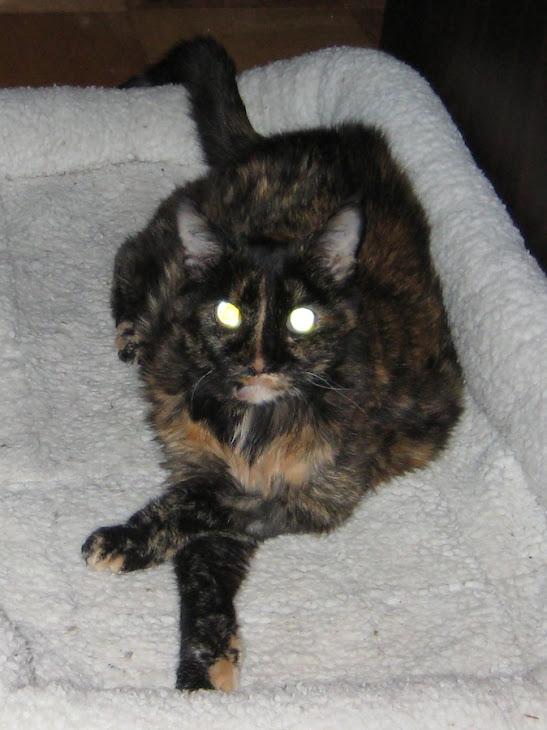Everything You Need to Know About Cat Claw Trimming
While we love our kitties, let's face it, they can be very destructive with their claws. But amputating their toes to "declaw" them is horribly inhumane: it can cause a lifetime of painful toes for them (imagine if your fingers were all amputated at the first joint below your fingernails; that's exactly what happens to a cat during declawing surgery). Declaw surgery can also lead to behavioral problems like aggression (when their first line of defense is taken away from them, some cats become more bitey) and litter-box avoidance (due to the pain in their feet when they try to dig there).
If you know these things and still choose to surgically have your cat's toes amputated, it will create mistrust between you and your cat; cats are very aware of everything. Imagine if you knew that the person who was supposed to be looking out for your welfare had chosen to maim you for life, just to preserve their furniture. Would that give you a warm, fuzzy feeling about them? It doesn't for the cats, either. You're far better off learning to trim your cat's claws and helping them learn where it's appropriate to scratch and where it's not.
Why do Cats Scratch Things?
In nature, cats scratch on things for a few reasons. These make perfect sense to the cats. Scratching is one of their natural instincts. It's as natural for them as eating, using the potty, and sleeping.
The first reason cats scratch things is to help their claws shed the outer layer of growth so the new growth can come in. Think of it as a necessary good-grooming practice, like we push back the cuticles on our nails.
The second reason cats scratch things is to exercise their front legs. The resistance they encounter on the scratching surface causes their muscles to work, just like when we work out with a resistance band.
Thirdly, cats scratch on things to mark their territory. Their paws have little scent glands that emit pheromones. We can't usually smell those, but other cats can. In the wild, cats mark the boundaries of their territory with spraying urine, leaving "scat" (poop), and by scratching to leave their scent on trees. Other cats encounter those messages and know they are on the boundary of a rival cat's territory.
Our domesticated cats retain these natural instincts. They don't understand why they're scratching things, they just know that they need to. It calms them and gives them a feeling of satisfaction. This is why using a spray bottle to spray your cat with water when they scratch something doesn't do anything to deter the cat from scratching, it only harms the trust bond between you and your cat. A cat doesn't differentiate between your fancy sofa and a tree in the wild; both seem to present an attractive scratching surface that can be used to accomplish the above three goals.
If your cat is scratching your furniture, carpet, or other things, examine whether you've provided sufficient acceptable scratching surfaces near the place where the cat is scratching. Look at the type of scratchers you have, and buy those based on how your cat scratches: vertically or horizontally. There are all types of scratchers available, so find one that appeals to your cat more than the unacceptable surfaces. These days, you can also usually find some that will appeal to your aesthetic, as well. Enhance the scratchers with catnip, if needed, to increase their attractiveness. You may want to use some clear packing tape around the corners of your furniture, which tend to be the most attractive areas, to make them slick so the cat's nails won't grab onto them. That's less obvious than a lot of other solutions and will protect your furniture. If you see your cat going for the furniture, say "No," calmly, then pick up the cat and place him/her on the scratcher. Cats are intelligent, so doing this consistently will teach them that the scratchers are their go-to surfaces in your home.
Why Do I Need To Trim My Cat's Claws?
But back to claw trimming! Even with regular use of appropriate scratching surfaces, a cat's claws keep growing, curling under and becoming sharper over time. If left untrimmed, they will keep growing right down into the cat's toes and stab them in the toe every time they take a step. That wouldn't be very comfortable, would it?
Just like you need a periodic manicure or pedicure, so do your cats. I refer to those with mine as their "pedi-pedi" since we're really grooming four feet instead of hands and feet.
Once trimmed to a safer length, your cat's claws will be less likely to get caught in the carpet when they walk or in their toys and scratchers when they use those. When kneading on you or reaching out for you, they'll be less likely to scratch you. Their toes will feel better, as well.
Cats, however, don't realize all these benefits, and they don't especially like having their claws trimmed. It doesn't seem like a natural thing to them. And they don't typically like being restrained, like you need to do when trimming claws.
Tools Needed for Trimming a Cat's Claws
I've used various types of fancy claw trimmers for cats, including the battery-operated files that file them down. What works best for me is a regular nail clipper for humans. It's quick and uncomplicated. And when you're trimming a cat's claws, speed is important. I use the larger size because it's easier to handle when you're trying to hold a squirmy cat.
If you know it's about time for a claw trim, it helps to position the trimmer in place ahead of time. Since I typically trim claws on my bed, I place it on the bedside table.
Conditioning a Cat for Claw Trimming
Long before you start trimming your cat's claws, you'll want to prepare the cat for this activity. Hold your cat a lot from the time it's young, talking or singing softly to the cat at a time when you are both calm. What do you talk about? Pretty much anything. Tell the cat that they're beautiful or good, or explain things to them, or reminisce about times you have spent together. Cats love to hear you say their name and enjoy little songs you make up that include their name.
As you're holding your cat and talking/singing, do a mini-exam of the cat's body. Slowly feel the kitty over for any abnormalities or injuries. Look at their ears to make sure there are no signs of ear mites. Check their anal area for fleas. Look for ticks if the cat has been outside. Check the condition of their coat and their teeth. Hold each of the cat's paws briefly, and gently push out each claw from its toe to check how sharp it is. Flip the cat over onto its back and gently rub its chest, checking the abdomen for any abnormalities, fleas, bald spots, or injuries. All the while, keep up the chatter or singing to calm your cat.
All of this should not have to take a long time; just a minute or two per cat. If you have more than one cat, you won't likely get to them all at the same time. Just be patient and get to it when it happens.
Choosing the Correct Time for Claw Trimming
Our cats pick up on our emotions, so your state of mind is key to a successful claw-trimming session. Times to avoid your cuddle sessions or claw trimming: when you're stressed or feeling frantic, when your cat has the "zoomies" and wants to run around and play, and when there's a lot of activity around your house or anything is out of the ordinary. Both of you should be relaxed and comfortable. As you get more in tune with your cat's emotions, you'll recognize when is the right time.
Good times for claw trimming: before bedtime when you're both relaxed, first thing in the morning, or during afternoon nap time can all be excellent times for it. If you trim the claws just before a meal, your cats may be more amenable to being handled and will be getting treat just afterward, so that's also a good time. But every family is different and every cat is different. What works for one may not work for another. Only you and your cat know when the time is right.
My Technique of Trimming Cat Claws
When one of my cats needs a claw trim, I choose a time when we're both calm and relaxed, just as with the cuddle sessions. Since I've already placed the claw trimmer handy, I don't need to go and get that. It's merely a matter of positioning the cat properly so I can control him and get the job done quickly.
For me, the place that works best is on my bed. That way, I can sit with my back to the headboard and hold the cat next to my body underneath my left arm, his rear-end backed up to the headboard. This way, he can't squirm out of my arm to the back. I have also trimmed the claws sitting on a sofa; anyplace where you can back the cat up against something so they can't get away will work.
I hold the cat under my left arm, with my left hand in front of his chest. Always talking or singing to the cat, take a moment if he gets too squirmy to pet, talk, and calm him down again.
When you're ready to trim, quickly take one of your cat's front paws in your left hand and gently push a claw out of the toe. Snip off the sharp tip, being careful not to cut into the quick (you can see the pink quick through a cat's white claws). Then move to the next toe, the next, and the next, also remembering to trim the dew claw a little higher up the leg from the rest of the toes.
Once one foot is done, spend a moment petting, talking, and calming the cat again before moving on to the other front foot. Follow a similar method for that paw until those claws are all done.
Now comes the tricky part: the back paws! For this, I pick up the cat with both hands and flip him over onto his back in my lap, his head closest to my torso and his back feet by my knees. You should have practiced this position during your cuddle sessions, so by now it's familiar and comfortable for the cat. Spend a moment talking, singing, and stroking the cat to make sure he's calm. He'll try to push your hand away with his back feet, but move quickly and trim each of the four toes on each back foot before he realizes what's happened.
When all four paws are done, keep holding and talking to the cat briefly to calm him again, then release him and tell him, "You're all pedi-pedied!" He will likely take off and go somewhere to groom himself.
Once you've done this, you won't believe how simple it is! I tend to trim my cats' claws about once a month. Since I have three cats, it typically takes a day or two to get to them all. Once one is done, the others pick up that cat's heightened emotions and will steer clear of you for a little while.
The Last Resort: A Pro
Some cats are more aggressive and will not tolerate being handled at all. But those cats still need their claws trimmed. If you cannot get your cat comfortable enough with handling to trim claws, you may need to use a professional groomer or your veterinarian to have this done.
When using a groomer, be careful who you use. Find one who likes and specializes in cats, not a dog groomer. Someone who understands cats' nature and is accustomed to working with them will traumatize your cat far less than someone who prefers working with dogs. Ask about whether they plan to sedate or restrain your cat for the procedure, and what other calming techniques they will be using. It's going to be stressful for your cat to go somewhere, anyway, so you don't want it to be any worse than it has to be. If you can find a cat groomer who will come to your home to trim the claws, that's even better.
After the first time you use a new groomer, observe your cat's behavior. Many cats pout after coming home from such a trip, but if the cat is unusually lethargic or hostile, listen to your instincts about whether to continue using that groomer.
In Summary
Cats have claws; it's a part of who they are. Those claws need regular trimming, just as our own nails do. this procedure does not have to be unpleasant, for you or for the cat. With a little patience, planning, and conditioning, you can easily trim your cat's claws so you can continue living happily together.























































